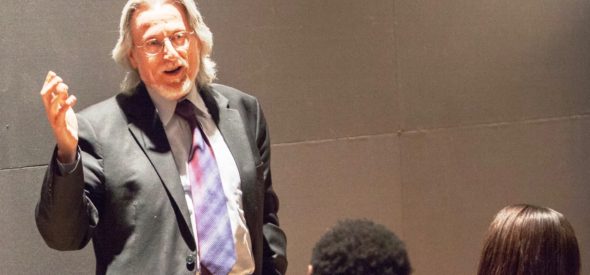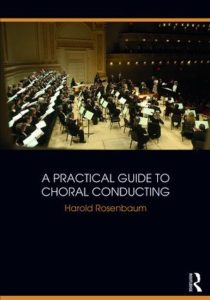Chapter 4: The Importance of Acquiring a Solid Conducting Technique – From Harold Rosenbaum’s Book A Practical Guide to Choral Conducting
Comments Off on Chapter 4: The Importance of Acquiring a Solid Conducting Technique – From Harold Rosenbaum’s Book A Practical Guide to Choral ConductingOctober 19, 2017 by Admin

 Harold Rosenbaum’s book, A Practical Guide to Choral Conducting, will be released in late October, 2017 by Routledge.The following is an excerpt from Chapter 4: The Importance of Acquiring a Solid Conducting Technique, as well as some helpful information about Mirror Conducting.
Harold Rosenbaum’s book, A Practical Guide to Choral Conducting, will be released in late October, 2017 by Routledge.The following is an excerpt from Chapter 4: The Importance of Acquiring a Solid Conducting Technique, as well as some helpful information about Mirror Conducting.
Chapter 4: The Importance of Acquiring a Solid Conducting Technique
It is not sufficient to be smart, charming, demanding, detail oriented, to know a great deal of choral repertoire, to have very good ears, to know music theory and history, to be knowledgeable in all aspects of running a choral organization, to be a psychologist and to treat your singers with respect. If your conducting technique is insufficient, you will lose the admiration of your singers and audience, not achieve the results you are after, and feel frustrated and inadequate. It may even affect your choice of repertoire if you are worried about certain passages which require crystal clear intent and instructions from you, multitasking, or rapidly changing gestures. This chapter focuses on exaggerated, inconsistent, distorted, and confusing motions which conductors often make that are both unnecessary and detrimental, and on the solutions to these problems. Correcting or averting them will make your singers more relaxed, confident, and more able to follow you, give you more confidence and preserve your energy, and allow you to have more control of any situation which might arise, from spontaneous shaping to correcting and preventing errors. Most of all it will yield better musical results, for your movements and gestures will truly reflect, shape, and convey the music, leading to a deeply satisfying performance which unifies all the components: composer, singers, and you, into a well-oiled machine
Perfect technique contains no wasted motion—no unnecessary or enlarged beats and no excessive hand, arm, and body movements. Some conductors erroneously believe that amateur or youthful singers will only see or respond to exaggerated motions, a notion which can actually do more harm than good, for the conductor employing them will develop a technique that serves only a particular type of choir’s needs, and therefore will be out of place, ineffective, and curious looking to most other choirs. Other forms of wasted motion such as mouthing words, continually bending the knees, and conducting too high or too low only detract from the main conveyors of your message, your arms and hands. Furthermore, wasted motion will make it more difficult for your singers when they work with other conductors who utilize smaller and more concise motions.
Beauty, grace, precision, clarity, energy, and expressivity – these are the essential qualities and products of superior conducting, articulated with arms, hands, fingers, and facial expressions. Those conduits will feel most comfortable and free, and will capture your singers’ attention fully, when your entire body feels stable and balanced, and when you have good posture. To achieve this, your feet should be about a foot apart with the left foot slightly in front of the right. However, any variation which works for you is fine, provided you are standing upright with good posture. Once you have settled on your own comfortable stance, you are ready to begin practicing physical gestures.
Mirror Conducting
 Mirror conducting occurs when the conductor gives the same pattern with both arms simultaneously but in opposite directions. Although mirror conducting should be used sparingly, because the arms generally have completely different functions, there are times when it can be quite useful, and even essential. Here are some of them:
Mirror conducting occurs when the conductor gives the same pattern with both arms simultaneously but in opposite directions. Although mirror conducting should be used sparingly, because the arms generally have completely different functions, there are times when it can be quite useful, and even essential. Here are some of them:
With an ensemble of hundreds, in passages requiring little or no subtlety, and where your most important task at the moment is keeping them together.
When the left arm would be otherwise idle for a few moments, and you can use it to reinforce the subtleties the right arm is attempting to convey.
hen the soloists on your right need you to focus on them, and yet the violin section on your left needs to be guided as well, or at least needs to see the beats
More about A Practical Guide to Choral Conducting, including pre-order information, at https://www.routledge.com/A-Practical-Guide-to-Choral-Conducting/Rosenbaum/p/book/9781138058446. Visit Harold at http://www.haroldrosenbaum.com/.
Category Sight, Sound, Word | Tags:
Comments Off on Chapter 4: The Importance of Acquiring a Solid Conducting Technique – From Harold Rosenbaum’s Book A Practical Guide to Choral Conducting
Sorry, comments are closed.


